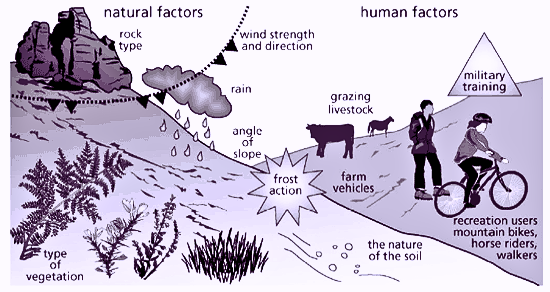Rocks transform into soil through the process of weathering, which can be both physical and chemical. Physical weathering occurs when natural forces such as wind, water, and temperature change cause rocks to break into smaller pieces without altering their chemical composition. Chemical weathering involves water and chemicals reacting with the minerals in rocks, changing them into different minerals, and breaking down the rock structure. Biological agents like plants, animals, and microorganisms also contribute to this process by physically and chemically altering the rock material, facilitating its breakdown into the soil.
The Basics of Soil Formation
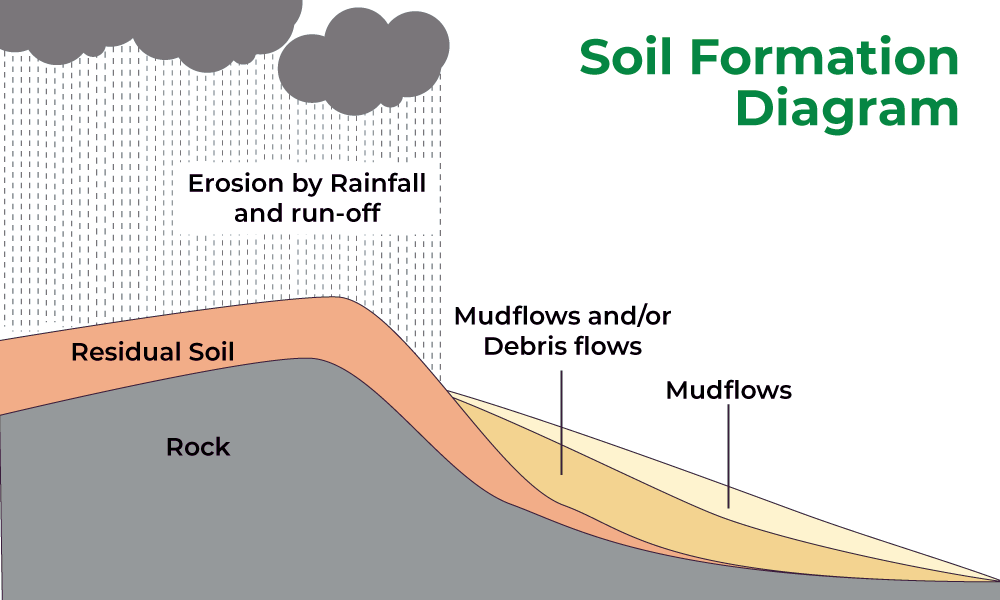
Soil formation, or pedogenesis, involves several key processes that transform parent material into the soil. These processes include:
- Transformations: The chemical weathering of materials like sand into clay minerals and converting organic matter into humus, making the soil fertile.
- Mineral weathering, nutrient cycling, and the breakdown of organic matter by soil microbes contribute significantly to soil formation, enriching the soil with essential nutrients.
- Five fundamental processes identified by pedologists that influence soil formation, including the soil’s physical, chemical, and biological properties.
- Environmental effects, place, and history play crucial roles in the genesis of soil, making each soil profile unique.
- Weathering and erosion are environmental processes that significantly alter the parent material, contributing to soil formation.
- Four major processes in soil formation are addition, loss, transformation, and leaching, each contributing to the development of soils in different ways.
What is Soil?
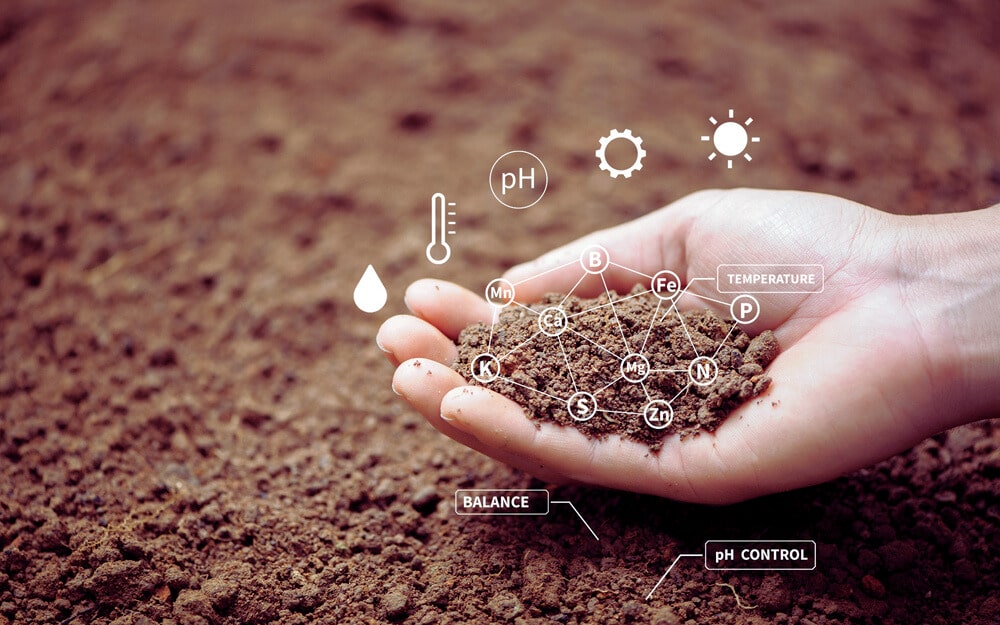
Soil is a complex mixture that supports life by providing a medium for plant growth, a habitat for organisms, and various ecosystem functions. The basic components of soil include minerals (approximately 45%), organic matter (about 5%), and the remainder being water and air (20-30%). It comprises air, water, minerals, and both living and dead plant and animal matter. These components are categorized into living and non-living parts. Soil texture, which is an important characteristic, refers to the relative proportions of sand, silt, and clay particles, independent of the soil’s chemical or mineralogical composition. Overall, soil composition is determined by various factors including air, water, minerals, and organic compounds both living and non-living. It’s also described as a mixture of organic matter, minerals, gases, liquids, and organisms, crucial for sustaining terrestrial life.
The Role of Rock in Soil
Rocks play a fundamental role in soil genesis, acting as the parent material from which soil is formed. The process begins with the environmental weathering of rocks, a crucial step in releasing nutrients into the forming soil. There are three major groups of rocks involved in soil formation: igneous, sedimentary, and metamorphic. Igneous rocks form from cooled molten mineral matter, sedimentary rocks from the accumulation of mineral and organic particles, and metamorphic rocks from the transformation of existing rock types under pressure and heat. Each type contributes differently to the soil depending on its mineral composition and the environment. The weathering of these rocks, both mechanically and chemically, leads to the development of soil by breaking down the rock material into smaller particles that blend with organic matter to create fertile soil.
The Process of Weathering
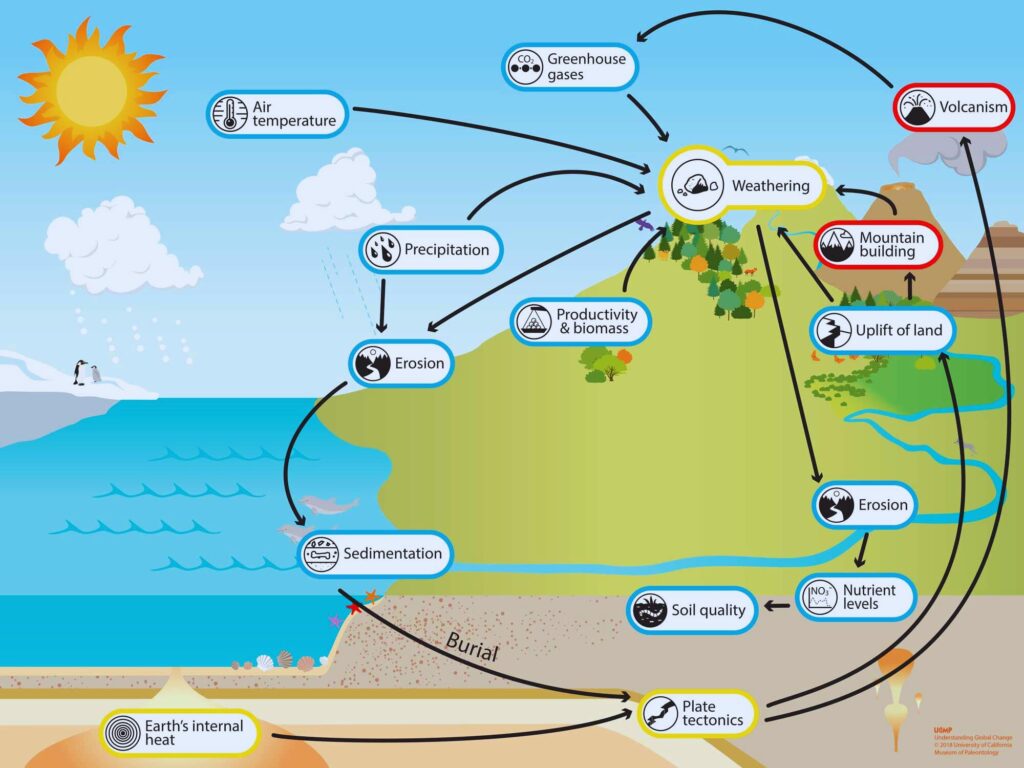
Weathering is the natural process that breaks down rocks and minerals at Earth’s surface into smaller pieces, leading to soil formation. This process can be classified into two main types: physical (mechanical) weathering and chemical weathering. Physical weathering involves the breaking of rocks into smaller pieces without changing their chemical composition. It can occur through various mechanisms such as exfoliation, freeze-thaw cycles, abrasion, root expansion, and wet-dry cycles. Chemical weathering, on the other hand, involves the alteration of the chemical composition of rocks and minerals due to reactions with water, acids, and other chemicals present in the environment. This type of weathering can result in the formation of new minerals and soil components. Together, physical and chemical weathering processes contribute to the development of soils by decomposing rocks and sediments and by incorporating decayed organic matter.
Physical Weathering
Physical weathering, also known as mechanical weathering, involves the breaking apart of rocks and crystals into smaller pieces without altering their chemical composition. This process can occur through various mechanisms, such as temperature changes leading to expansion and contraction, water freezing and thawing within rock cracks (which causes the rock to break apart), abrasion from wind or water-carrying particles that wear down rock surfaces, and biological activities where plants or animals break rocks through growth or movement. The result of physical weathering is the reduction of large rocks into smaller pieces, eventually contributing to soil formation without changing the rock’s chemical makeup.
Freeze-Thaw Action
Freeze-thaw weathering, also known as frost weathering, is a process that occurs in cold climates where water repeatedly freezes and thaws in the cracks of rocks. This cycle involves water entering cracks during warmer periods; as temperatures drop, the water freezes and expands, exerting pressure on the rock. The expansion of ice can cause the rock to crack and eventually break apart. Over time, with repeated freezing and thawing cycles, the rock disintegrates into smaller pieces. This type of weathering is particularly effective in porous or permeable rocks, which allow water to seep in easily.
Exfoliation
Exfoliation is a physical weathering process characterized by the peeling off of layers from massive rock bodies, such as granite or basalt. This occurs when large, curved plates or slabs of rock are stripped away from the outer surface of the rock, often resulting in the formation of exfoliation domes or dome-like hills. The process can be caused by various factors, including temperature changes, which lead to the expansion and contraction of the rock, thereby inducing stress that causes the outer layers to peel off. Additionally, the removal of overlying materials can decrease pressure on the rock surface, leading to expansion and fracturing along sheet-like joints. Water can also enter these cracks, promoting further chemical weathering and enhancing the exfoliation process.
Chemical Weathering
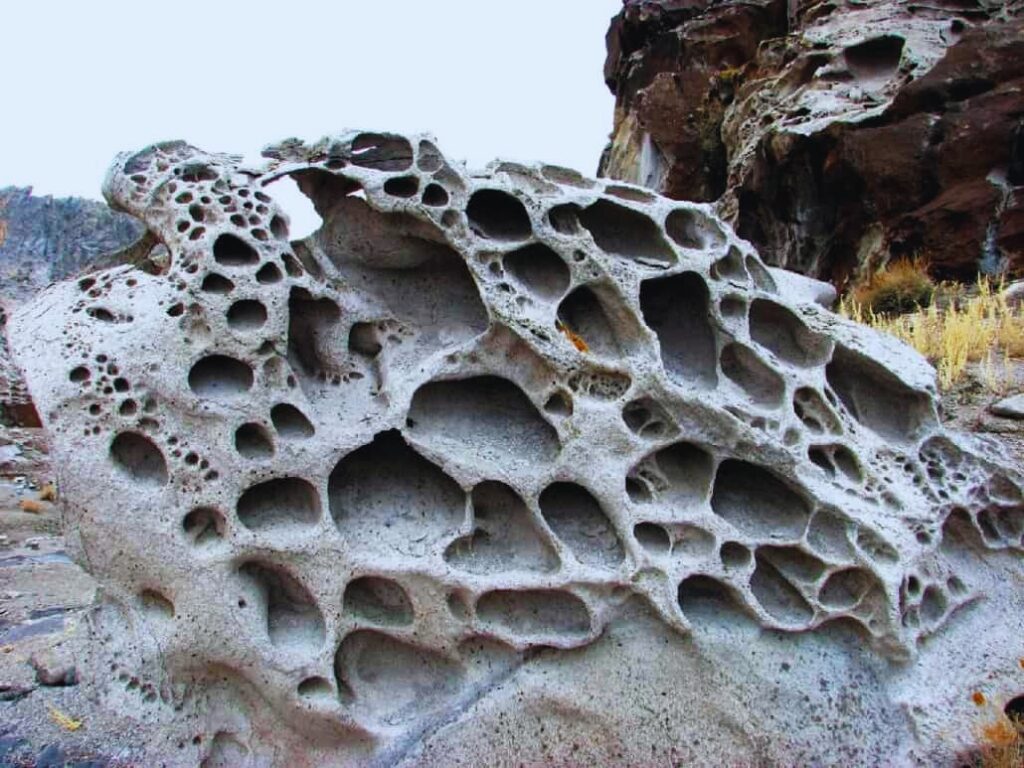
Chemical weathering is the process that breaks down rocks through chemical changes. This type of weathering changes the chemical composition of rocks, often transforming them into different materials. Key types include:
- Hydrolysis: Reaction between rock minerals and water, altering the mineral structure to form new compounds.
- Oxidation: Oxygen reacts with minerals, especially those containing iron, leading to rust formation which weakens the rock.
- Carbonation: Carbon dioxide in rainwater forms carbonic acid, which reacts with minerals like calcium carbonate in limestone, dissolving them.
- Acid Rain: Caused by industrial pollutants, acid rain accelerates chemical weathering by reacting with minerals in the rock, leading to rapid deterioration.
These processes lead to significant landscape changes over geological timescales, contributing to soil formation and the sculpting of Earth’s surface features.
Hydrolysis
Hydrolysis is a fundamental chemical weathering process involving the reaction between water and rock minerals, leading to the breakdown and alteration of the minerals. In this process, water molecules chemically react with minerals, causing them to decompose and form new compounds. This reaction can significantly alter the mineral composition of rocks, contributing to the weakening and disintegration of the rock over time. Hydrolysis is particularly effective on silicate minerals, which are abundant in the Earth’s crust. The reaction leads to the formation of clay minerals and the release of soluble ions into the environment, which are then carried away by water, further contributing to the landscape’s alteration.
Oxidation
Oxidation is a key type of chemical weathering that occurs when oxygen reacts with minerals, particularly those containing iron, leading to the formation of oxides. This reaction often results in the reddish-brown color characteristic of rust, which is commonly seen on rocks and soil surfaces. Oxidation changes the chemical composition of minerals, making them weaker and more prone to further weathering and erosion. This process is significant in shaping Earth’s landscapes by breaking down rocks and minerals over time, contributing to soil formation and the alteration of geological features.
Biological Contributions
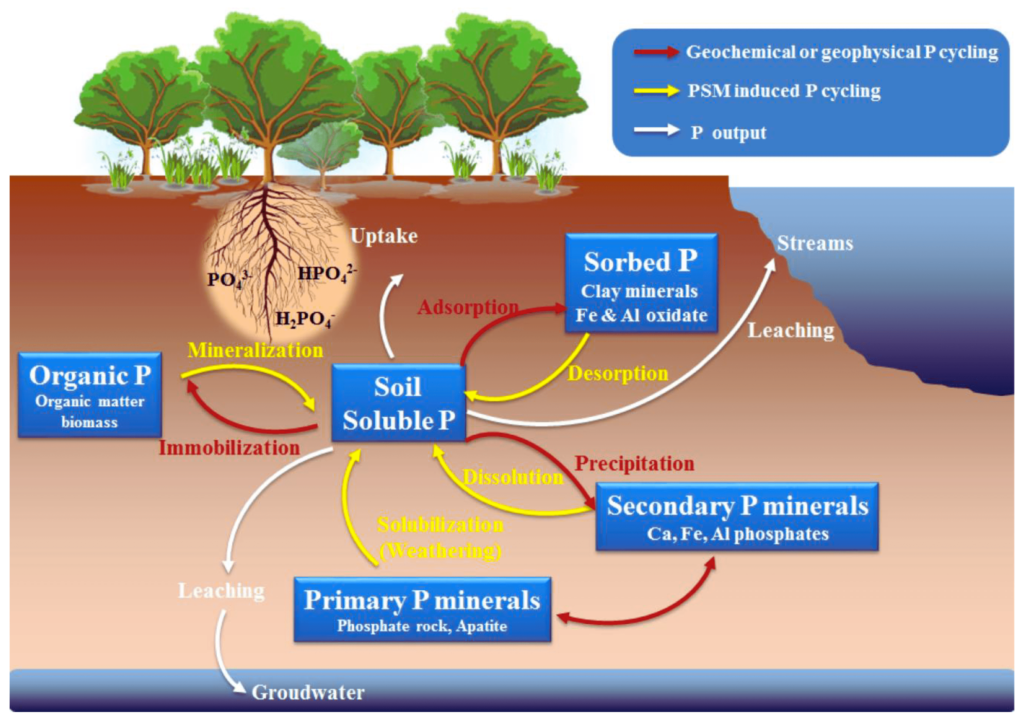
Microorganisms play a pivotal role in nutrient cycling in soils, acting as essential agents for transforming and mobilizing nutrients vital for plant growth and ecosystem health. They decompose organic matter, releasing nutrients like nitrogen, phosphorus, and sulfur into the soil in forms accessible to plants. This process not only enriches the soil but also supports the carbon cycle by breaking down carbon-based plant and animal material. Soil microorganisms, including bacteria, fungi, and protozoa, participate in various biochemical processes that contribute to the soil’s physical structure and fertility, promoting aeration, water retention, and resistance to erosion. Through symbiotic relationships, such as those between nitrogen-fixing bacteria and plant roots, microorganisms enhance plant nutrient uptake, improving plant health and growth. Their activities are crucial at different stages of ecosystem development, influencing soil stability, composition, and the overall function of terrestrial ecosystems.
Plant Roots
Plant roots contribute significantly to the process of weathering, which is the breakdown of rocks into soil. They engage in both mechanical and chemical weathering in several ways:
- Mechanical Weathering: Roots grow into the cracks and nooks of rocks, and as they expand, they exert pressure on the rocks, causing them to break apart. This process, known as root pry, can lead to significant mechanical weathering of rocks.
- Chemical Weathering: Plants can also cause chemical weathering by releasing acidic compounds through their roots. These compounds can chemically break down the minerals in rocks, altering their composition and contributing to the formation of soil.
- Generation of Sediment: Beyond breaking rocks, plant roots can also promote the generation of sediment. They enhance the stability of soil by reducing its mobility and erodibility, which contributes to the formation of more stable landforms.
Overall, plant roots play a crucial role in both the mechanical disintegration and chemical decomposition of rocks, contributing to soil formation and landscape evolution.
Microorganisms
Soil microorganisms play a crucial role in soil health and fertility by influencing nutrient cycling, soil formation, and plant growth. They are involved in decomposing organic matter, which releases essential nutrients like nitrogen, phosphorus, and potassium back into the soil, making them available to plants. Microorganisms, including bacteria, fungi, and protozoa, form symbiotic relationships with plant roots, enhancing nutrient absorption and protecting plants from pathogens. They are integral to the process of soil aggregation, which improves soil structure and its ability to retain water and nutrients. Additionally, soil microbes are fundamental in controlling the flux of major nutrients, thus directly affecting ecosystem productivity and plant health.
Animals
Animals significantly contribute to biological weathering, a natural process that breaks down rocks and minerals through the actions of living organisms. Various animals, including burrowing species like shrews, moles, earthworms, and ants, play a crucial role in this process. These creatures burrow into the soil, creating pathways that allow water and air to penetrate deeper, facilitating further weathering of the underlying rock material. Additionally, animals such as birds that forage for seeds can also inadvertently contribute to weathering by disturbing the soil and rock surfaces. The activities of these animals not only enhance soil formation but also contribute to the overall ecosystem by aiding in nutrient cycling and soil aeration, demonstrating the interconnectedness of biological and geological processes.
Soil Horizons and Composition
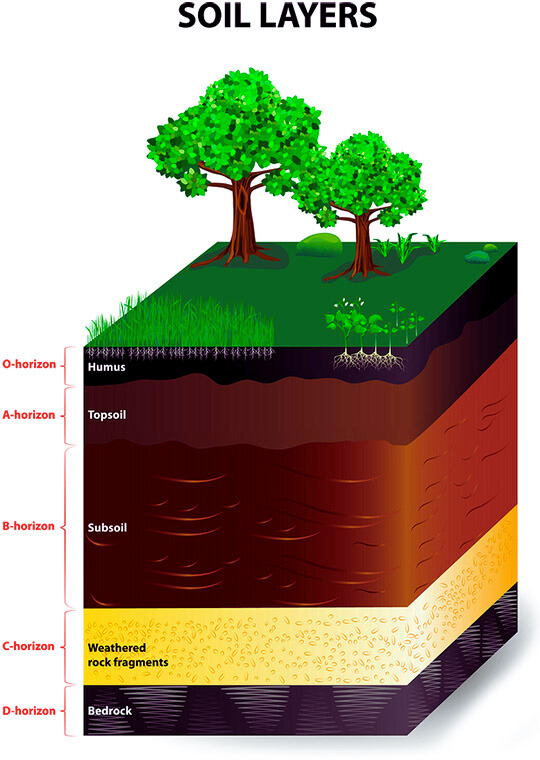
Soil horizons are distinct layers within the soil that have unique physical, chemical, and biological characteristics. These layers are parallel to the soil surface and differ from the layers above and beneath them. The major soil horizons include:
- O Horizon: Comprised mostly of organic matter such as humus. It is the topmost layer in some soils, rich in decomposed organic material.
- A Horizon: Often referred to as topsoil, it is where most organic matter accumulates and is mixed with mineral particles, providing nutrients for plants.
- B Horizon: Known as the subsoil, it is characterized by the accumulation of minerals and nutrients leached from the A horizon. It often contains more clay and mineral deposits.
- C Horizon: Consists of partially weathered parent material. This layer has the least weathering and is primarily made up of the rock from which the soil has formed, with very little organic material mixed in.
A soil profile is the complete set of soil horizons present at a specific location, effectively a vertical section of the soil that reveals all its layers.
The Role of Time in Soil Formation
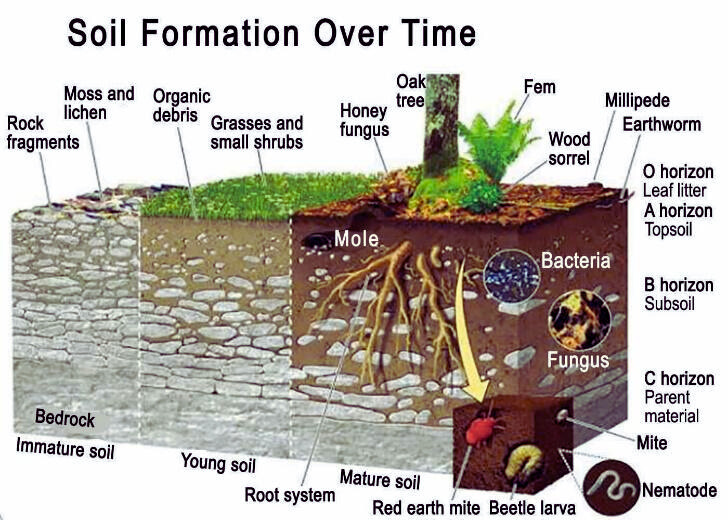
Time plays a crucial role in soil formation, serving as one of the five main factors alongside parent material, climate, topography, and biological activity. Over time, soil evolves through the processes of weathering, the breakdown of rocks and minerals which provides the material for soil formation. The length of time can significantly influence the extent of weathering, accumulation of organic matter, and development of soil layers or horizons. Longer periods allow for more substantial changes in soil properties and greater development of soil profile. This process can be influenced by various factors including climate, the nature of the parent material, and biological activity, all of which interact over time to form soil.
Human Impact on Soil Formation
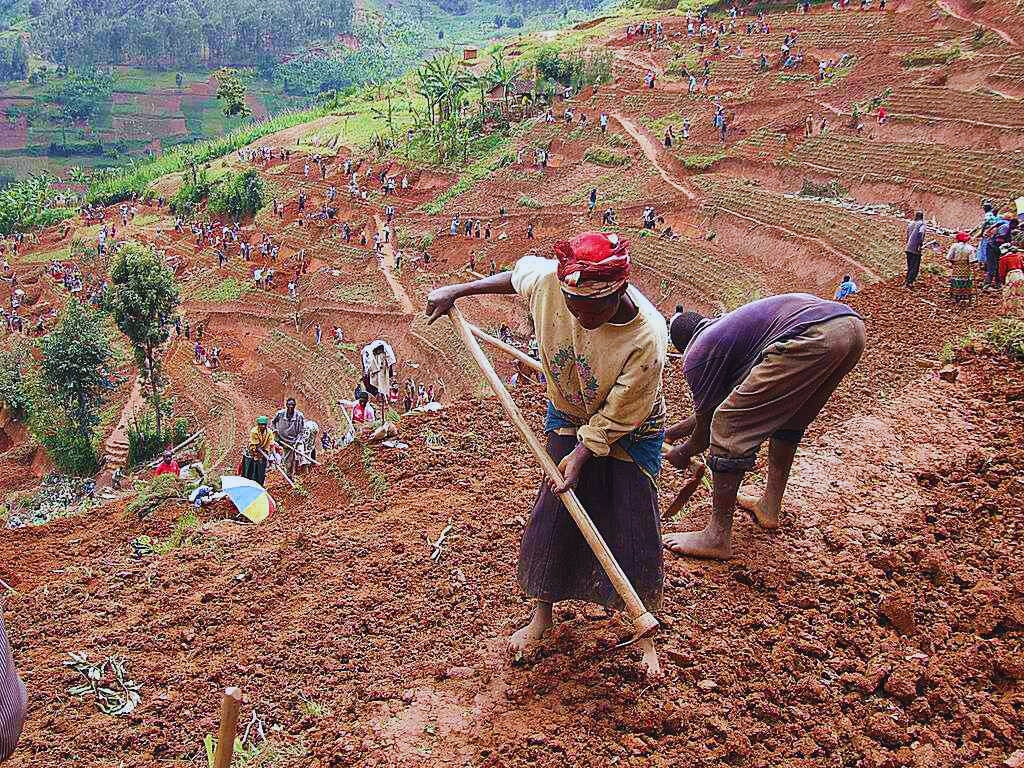
Human activities significantly impact soil formation and its properties. These impacts include altering the soil’s physical structure, chemistry, and biology. Key human-driven changes involve:
- Conversion of Natural Landscapes: Changing natural landscapes into agricultural or urban areas dramatically affects soil formation processes and can lead to soil degradation.
- Agricultural Practices: Practices like irrigation, deep plowing, and the use of genetically engineered crops alter soil characteristics. These can contribute to soil erosion, compaction, and changes in soil chemistry and organic matter content.
- Soil Erosion due to Climate Change and Human Activity: Changes in rainfall patterns and vegetation cover, often accelerated by human activities, can lead to increased soil erosion, further affecting soil formation and degradation.
Overall, human activities impact all soil-forming factors, leading to accelerated soil changes that can significantly influence soil quality and sustainability.
Conclusion
From the might of a mountain to the humble ground we walk on, the transformation of rock into soil is a complex, fascinating process that underscores the dynamic nature of our planet. It reminds us of the interconnectedness of all things and the importance of caring for our soil, ensuring it remains fertile and vibrant for generations to come.
Read also: What Are the Main Causes of Injuries When Using Forklifts?
